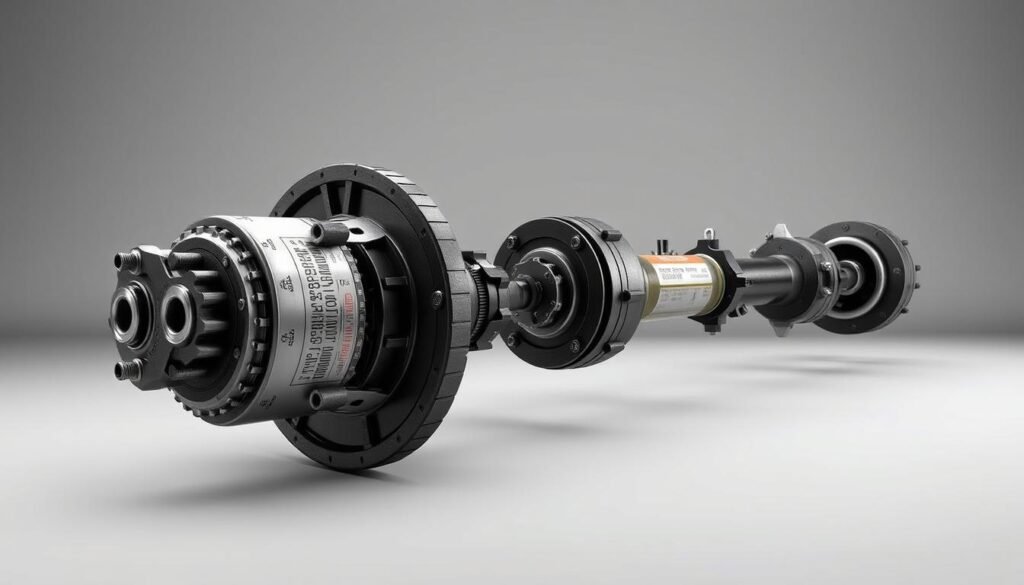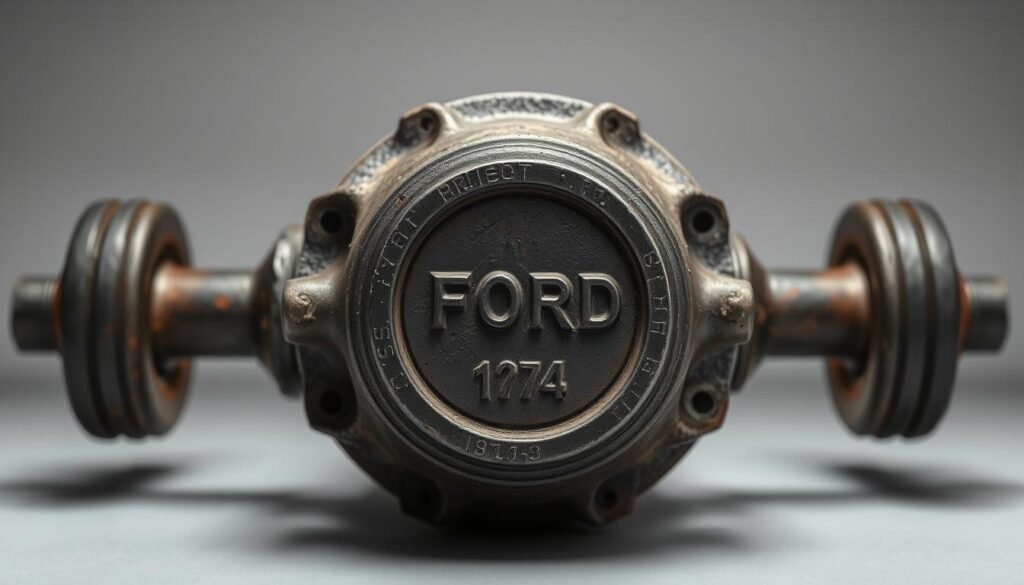Ford Rear Axle Identification Codes: Identify Your Model
Ever wondered how to spot the rear axle of your Ford? Knowing the Ford rear axle identification codes is key to keeping your car in top shape.
This guide will teach you how to find your model’s rear axle. It’s a vital part of your car’s performance. Here, you’ll discover how to read Ford axle identification codes.
You’ll also learn where to find tags on your vehicle. This knowledge helps you with maintenance and making smart upgrade choices.
Ready to learn about Ford axle identification? By the end of this guide, you’ll know how to spot your model’s rear axle with ease.
Introduction To Ford Rear Axle Identification
Knowing how to identify your Ford axle is key for car owners. It’s essential for maintenance or upgrades.
This guide helps you figure out your axle type, which is important for parts compatibility. Using the Ford axle identification guide is a must.
It helps you understand the differences in axles. Each has its own specs, affecting gear ratios and performance. Learning about Ford rear axle identification is empowering.
It lets you make smart choices for repairs and upgrades. This way, your car stays in top shape, meeting your driving needs.
What Is The Importance of Differential Identification?
Knowing your vehicle’s differential is key for several reasons. It makes sure you get the right parts for replacements. The right parts are critical to avoid performance problems.
Getting your differential right is the first step in fixing issues. It helps find and fix problems quickly. It’s also important for upgrades, making sure they work well.
Compromise your differential helps with your vehicle’s performance and safety. It lets you make better choices about how your car handles.
For these reasons, knowing your differential is vital for any Ford owner.
| Aspect | Importance |
|---|---|
| Part Compatibility | Ensures correct fit when replacing or upgrading components. |
| Issue Diagnosis | Facilitates prompt identification and troubleshooting of problems. |
| Performance Insights | Enhances understanding of vehicle handling and stability features. |
| Cost Efficiency | Prevents costly errors by avoiding misfit parts and repairs. |
Ford Rear Axle Identification Codes Explained
Knowing how to read Ford rear axle identification codes is key. They tell you about your vehicle’s axle, like gear ratios and differential types. This info is important for car owners and mechanics alike.
Purpose of Identification Codes
These codes help share axle info clearly. They make talking about repairs or upgrades easier. Here’s why they’re important:
- They clarify gear ratios and differential types.
- They standardize axle specs for easy reference.
- They help with accurate maintenance and repairs.
Common Formats of Identification Codes
Ford rear axle codes come in different formats. They use letters and numbers to show important specs. Here are some common ones:
| Code Format | Details |
|---|---|
| Low-High Number Format | Example: 3L73 indicates a 3.73 gear ratio. |
| Letter-Number Combination | Example: H7 denotes a specific differential type. |
| Alphanumeric String | Combination of letters and numbers providing detailed info. |

Where To Find Ford Axle Identification Tags?
Finding Ford axle identification tags is key to knowing your vehicle’s rear axle details. These tags hold important info like differential type and gear ratio.
The tag’s location can vary by model and year. It’s usually on the rear differential cover, but knowing where it is for your model saves time.
Location on Different Models
The axle identification tag’s spot changes across Ford models. Here are some common places:
- Mustang: Rear differential cover, usually bolted on.
- F-150: Near the rear axle housing, on the driver’s side.
- Explorer: Attached to the differential itself, positioned along the edge.
- Bronco: On the rear axle assembly, often underneath the cover plate.
Interpreting The Tag Information
Once you find the tags, reading them is easy. The tag usually shows:
- Differential Type: This might include descriptions like open, limited slip, or locking.
- Gear Ratio: This indicates the ratio of turns the driveshaft makes compared to the axle wheels.
- Assembly Date: The date when the differential assembly was produced.
Knowing this info helps you make smart choices for repairs, maintenance, and upgrades for your Ford vehicle.

Decoding Ford Rear Axle Identification Codes
It’s important to understand Ford rear axle identification codes for your vehicle’s maintenance and upgrades.
Each code on the axle tag tells you about the axle type, gear ratio, and more. Knowing these codes helps you make better choices for repairs and improvements.
Common Codes and Their Meanings
Ford rear axle codes are made up of letters and numbers. They show important details about your axle.
Here’s a table with common codes and what they mean:
| Code | Meaning |
|---|---|
| 8.8 | Indicates an 8.8-inch rear axle, commonly found in Ford trucks and cars. |
| 9 | Refers to a 9-inch rear axle, popular in classic Ford muscle cars. |
| 3.73 | Denotes a gear ratio of 3.73:1, balancing speed and fuel use. |
| LIMITED | Signifies a limited-slip differential, improving traction in different conditions. |
Using a Ford Axle Code Decoder
A Ford axle code decoder makes understanding these codes easier. It turns the codes into clear information about your axle.
This is great for planning maintenance or upgrades, as it helps you make informed choices.

Using Ford Rear Axle Serial Numbers
Knowing about Ford rear axle serial numbers is key for car owners. These numbers tell you when and how your axle was made. They are usually found on the axle housing, making them easy to spot.
By using this info, you can find the right parts for your car. It also helps you understand your car’s history better.
Finding The Serial Number on Your Axle
To find the serial number on your Ford rear axle, just follow these steps:
- First, clean the axle housing to see the markings clearly.
- Then, check the rear part of the axle where it meets the differential.
- Look for a series of numbers stamped into the metal. This is your Ford rear axle serial number.
- Also, note any letters nearby. They can give more details about your axle’s features.
How Serial Numbers Relate To Identifying Models?
The serial numbers on your rear axle help identify your Ford model. By decoding these numbers, you can learn:
- The exact year your axle was made, which is helpful for repairs or replacements.
- Which parts are compatible with your car, important for any changes or restorations.
- Unique features of your model that might not be obvious at first glance.

Learning how to find and decode your axle’s serial number is very useful. It helps you take better care of and fix your car more effectively.
Ford Rear Differential Identification Techniques
Even without standard tags or serial numbers, you can identify a Ford rear differential.
Use visual identification methods to guess the axle type. These methods focus on the differential’s specific features.
Visual Identification Methods
Visual identification can help you figure out your rear differential type. Start by looking at the differential cover’s shape. You might see an oval, square, or rounded shape.
Each shape usually points to a specific model. Also, count the bolts holding the cover. Different models have different bolt setups.
And don’t forget to measure the ring gear’s diameter and width. These measurements can help narrow down your search.
Common Characteristics To Note
When trying to identify a Ford rear differential, pay attention to a few key things:
- Cover Shape: The shape of the differential cover is very important.
- Number of Bolts: The number of bolts can give you clues about the axle type.
- Ring Gear Dimensions: Measure the diameter and width of the ring gear for more information.
- Tag Location: If there’s a tag, note where it is. It might match the model.
Ford Rear Axle Ratio Identification
Knowing about axle ratios is key to better vehicle performance. The gear ratio affects how power moves from the engine to the wheels.
It impacts acceleration and fuel use. By learning about Ford rear axle ratios, you can pick the best one for your driving style.
Learning Gear Ratios
Gear ratios show how many teeth two gears have. A higher ratio means more torque for quicker starts.
A lower ratio helps save fuel on long drives. Knowing this balance helps you understand your driving experience.
How To Calculate Your Axle Ratio?
There are easy ways to figure out your axle ratio. You can count turns or look at axle codes. Here’s how to do it right:
- Count how many drive shaft turns match each axle turn.
- Use the formula: Axle Ratio = Driveshaft Turns / Axle Turns.
- For codes, check the tags to find your ratio.
| Axle Ratio | Torque Characteristics | Performance Impact |
|---|---|---|
| 3.31 | Moderate Torque | Balanced for daily driving |
| 4.10 | High Torque | Enhanced acceleration, lower top speed |
| 2.73 | Low Torque | Better fuel efficiency, less acceleration |
What is a Bill of Material (BOM) Number?
A Bill of Material (BOM) number is key in finding out about axles. It’s a special code that holds important details about axle parts.
Knowing your BOM number helps you find the right info for fixing or maintaining your vehicle.
Importance of BOM in Axle Identification
The Bill of Material number is essential for identifying axle parts correctly. It helps you tell apart parts that look similar but have different jobs.
Having the right BOM number makes it easier to get the right parts for your vehicle.
How To Use BOM For Identification?
To use BOM number identification for axle parts, follow these steps:
- Find the Bill of Material number on your vehicle’s papers or the axle itself.
- Check the BOM against a database or parts catalog to learn about the axle model.
- Use what you find to make sure you’re getting the right parts or service info.
Guide To Ford Rear Axle Tag Guide
Compromise the Ford rear axle tag guide is key to knowing your vehicle’s axle details. By reading the tag, you learn about your rear axle’s type and what it can do.
Each Ford model has its own tagging system, which has changed over time. It’s important to know the common patterns for different years.
Reading The Axle Tag
Start by finding the axle tag on the axle housing. It holds important info like the gear ratio, production date, and where it was made.
Knowing the codes helps you understand your axle’s performance.
Common Tag Patterns by Year
Tag patterns have changed over the years, showing how Ford’s production methods have evolved.
Here’s a quick guide to common patterns you might see:
| Year | Common Pattern | Example Format |
|---|---|---|
| 1965-1980 | Basic Numeric and Alpha Codes | 1A5D |
| 1981-1990 | Expanded Numeric System | 3D28A |
| 1991-2000 | Increased Detail with Year Indicator | F3UZ-4205-BB |
| 2001-Present | Composite and Numeric Codes | 1F1R-2115-DC |
Knowing these patterns helps you understand the axle tag better. It’s essential for using the Ford rear axle tag guide effectively.
Conclusion
Mastering Ford rear axle identification is key to keeping your car running well. Knowing your Ford’s rear axle details helps you make smart choices for repairs and upgrades.
This ensures your car works its best and lasts longer. Learning to find and understand identification tags, serial numbers, and BOM numbers boosts your car care skills.
This knowledge lets you tackle any car problems with confidence. It makes you more capable of fixing issues.
Remember, knowing your axle is vital for car care. With this knowledge, you can handle Ford rear axle details with ease. This leads to better car maintenance and reliability.
FAQs
Q: How can I find the rear axle identification codes on my Ford vehicle?
A: Look for the axle identification tag on the rear differential cover. It’s where you’ll find the codes. Check your owner’s manual for the exact spot, as it varies by model and year.
Q: What do Ford rear axle identification codes mean?
A: These codes tell you about your axle’s gear ratios and type. They’re a mix of letters and numbers. By decoding them, you’ll know exactly what your axle is.
Q: Why is it important to identify my axle type?
A: Knowing your axle type is key for part replacements, diagnosing issues, and upgrades. If you get it wrong, you might face fitment problems and extra costs.
Q: How do I decode Ford rear axle codes?
A: Use a Ford axle code decoder or Ford’s guide to decode the codes. This will turn the codes into clear specifications for your axle.
Q: Where can I find the serial numbers on my Ford rear axle?
A: Look for the serial numbers on the axle housing. They’re stamped there. This info is vital for knowing your vehicle’s production date and axle details.
Q: What visual cues can I use for differential identification?
A: Check the cover shape, bolt count, and ring gear size to identify your differential. These clues can help guess your axle type if the tag is missing or hard to read.
Q: How do gear ratios affect my vehicle’s performance?
A: Gear ratios affect power and torque. Lower ratios help with acceleration and climbing, while higher ratios improve fuel efficiency at high speeds. Choose the right ratio for your driving habits.
Q: What is a Bill of Materials (BOM) number and how is it used?
A: A BOM number identifies your axle’s components and specs. It makes identification easier and gives you access to detailed technical info for maintenance and repairs.
Q: How can I read the axle tag for older Ford models?
A: Older Ford models have different axle tag patterns. Learn these patterns by year to accurately decode your vehicle’s tag.







